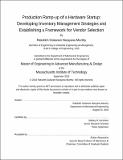| dc.contributor.advisor | Stanley B. Gershwin. | en_US |
| dc.contributor.author | Gokaram Narayana Murthy, Rakshith | en_US |
| dc.contributor.other | Massachusetts Institute of Technology. Department of Mechanical Engineering. | en_US |
| dc.date.accessioned | 2017-01-30T18:50:44Z | |
| dc.date.available | 2017-01-30T18:50:44Z | |
| dc.date.copyright | 2016 | en_US |
| dc.date.issued | 2016 | en_US |
| dc.identifier.uri | http://hdl.handle.net/1721.1/106689 | |
| dc.description | Thesis: M. Eng. in Advanced Manufacturing & Design, Massachusetts Institute of Technology, Department of Mechanical Engineering, 2016. | en_US |
| dc.description | This electronic version was submitted by the student author. The certified thesis is available in the Institute Archives and Special Collections. | en_US |
| dc.description | Cataloged from student-submitted PDF version of thesis. | en_US |
| dc.description | Includes bibliographical references (pages 113-116). | en_US |
| dc.description.abstract | It is imperative for hardware startups to have a clear plan of action while scaling-up production. Manufacturing and operations related activities should be accorded the same importance as design and engineering. New Valence Robotics Corporation (NVBOTS), a high-technology automated 3D printing manufacturing startup was experiencing high growth. The demand for their 3D printers was rising and they were looking to expand into new markets. In order to ramp up production and meet growing needs of the market, it was an absolute necessity to restructure their production planning and inventory management strategies. Inventory is the life-blood of every organization and mandates efficient management, especially for startups which have significant cash constraints. Most big organizations have sophisticated ERP systems and dedicated inventory personnel that help in efficient inventory management. This thesis aims to assist startups that lack the above mentioned luxuries. The purpose of this thesis is to help NVBOTS: (1) to efficiently manage inventory by classifying them into groups with similar characteristics, (2) to determine how much and when to order each type of SKU so as to minimize capital requirements, (3) to accurately keep track of on-hand, incoming and outgoing inventory, (4) to provide a framework for vendor selection. Some of the inventory classification methods considered include ABC analysis, Price vs Lead Time trends, by part type and by vendor. After inventory was classified, Economic Order quantity, Economic Production Quantity, QR and Base Stock models were applied to each of the categories. The results from these models were analysed and then appropriate ordering strategies were decided for each of the categories. The thesis also suggests some common practices for physical inventory control including inventory room layout, 5S methods and cycle counting. In addition to this, the vendor matrix method of rating vendors provides a methodology to qualify vendors, based on certain criteria. | en_US |
| dc.description.statementofresponsibility | by Rakshith Gokaram Narayana Murthy. | en_US |
| dc.format.extent | 116 pages | en_US |
| dc.language.iso | eng | en_US |
| dc.publisher | Massachusetts Institute of Technology | en_US |
| dc.rights | MIT theses are protected by copyright. They may be viewed, downloaded, or printed from this source but further reproduction or distribution in any format is prohibited without written permission. | en_US |
| dc.rights.uri | http://dspace.mit.edu/handle/1721.1/7582 | en_US |
| dc.subject | Mechanical Engineering. | en_US |
| dc.title | Production ramp-up of a hardware startup : developing inventory management strategies and establishing a framework for vendor selection | en_US |
| dc.type | Thesis | en_US |
| dc.description.degree | M. Eng. in Advanced Manufacturing & Design | en_US |
| dc.contributor.department | Massachusetts Institute of Technology. Department of Mechanical Engineering | |
| dc.identifier.oclc | 969775787 | en_US |
